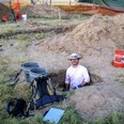
- American Material Culture,
- Applied Statistics,
- Archaeological Anthropology,
- Art and Materials Conservation,
- Categorical Data Analysis,
- Comparative Methodologies and Theories,
- Cultural History,
- Cultural Resource Management and Policy Analysis,
- Databases and Information Systems,
- Epistemology,
- Geographic Information Sciences,
- Graphics and Human Computer Interfaces,
- Historic Preservation and Conservation,
- Human Geography,
- Interdisciplinary Arts and Media,
- Multivariate Analysis,
- Other History of Art, Architecture, and Archaeology and
- Philosophy of Science
Three-dimensional (3D) digital scanning of archaeological materials is typically used as a tool for artifact documentation. With the permission of the Caddo Nation of Oklahoma, 3D documentation of Caddo funerary vessels from the Vanderpool site (41SM77) was conducted with the initial goal of ensuring that these data would be publicly available for future research long after the vessels were repatriated. A digital infrastructure was created to archive and disseminate the resultant 3D datasets, ensuring that they would be accessible by both researchers and the general public (CRHR 2014a). However, 3D imagery can be used for much more than documentation. To illustrate this, these data were utilized in a 3D morphometric analysis of the intact and reconstructed vessels to explore the range of variation that occurs in ceramic vessel shape and its potential contribution to the local ceramic taxonomy. Results of the 3D morphometric analysis demonstrate the potential for substantive analytical gains in discussions of temporal resolution and ceramic technological organization in the ancestral Caddo region.

Supplemental material can be downloaded from http://saa.metapress.com/content/r0131rv5615np242/?p=45963bbc243a4499a68dd05c327de5d7&pi=0.